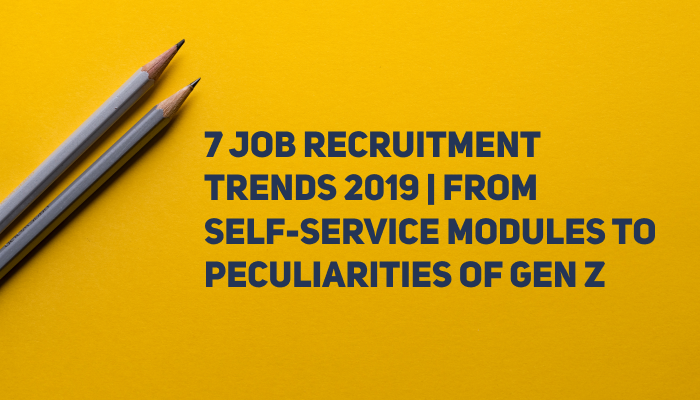
Now, with more than a quarter way into the year, it’s obvious how some of the trends forecasted at the end of the previous year have already been well-ingrained in recruitment while others are still in their nascent stages. We’ll attempt to cover them both in this article. Specifically, we’ll look at how remote work is changing the landscape of the workforce, how automation and artificial intelligence govern employee management, and why it’s important to care for employee engagement and generational shifts.
Remote Work & Mobile Work Environment

In our article on Remote Work Statistics, we wrote that 50% of the workforce was going to be remote by 2020 and that the number of 100% remote US companies was steadily growing. Moreover, according to the study by Stanford, remote workers’ productivity was 13% higher than that of office employees. Also, we wrote that remote workers were clearly cheaper and saved companies up to 7,000 dollars a year on food, drinks, commute, child care. Since remote work opens up talent pools unrestricted by geographical borders, it’s definitely one of the huge trends in recruitment nowadays. One of the other directions, the hiring is heading, which is clearly connected with remote work, is companies starting to offer a flexible working environment as part of their benefits packages to attract more candidates.
However, remote work is not without its challenges. First off, it’s important to keep your remote workers connected by organizing video meetings and chats to avoid the lack of communication and understanding between the co-workers and management. Moreover, if you plan to transition partly or in-full to employing a remote workforce, you definitely need to consider changing your whole approach to a hiring process, incorporating new tools, applications, and even policies that will help close the geographical distance, improve tracking, onboarding, and coordinating remote employees. Apart from remote workforce tools, employers need to think about additional security measures that would safeguard their trade data.
Collaboration & Workforce Analytics

Despite the continuous shift towards “digital nomadism,” communication is key in the modern business environment. A competent HR manager will strive to encourage everyday communication as much as possible. One of the tools for promoting collaboration is on-going workforce analytics. Workforce analytics is based around asking questions and interviewing people about workplace satisfaction and their job environments, which is outright important for getting real-time feedback from employees. Instead of conducting annual or biannual surveys, companies need to start from the very beginning, that is onboarding, and keep it up with monthly follow-ups if need be. Mood management, employee preferences, and other targeted data are crucial for keeping talent and improving the organizational environment. Another reason for continuous analytics is to establish productivity metrics by gathering data from top performers and analyzing the key environmental characteristics that fostered that same highly productive performance. Also, the appropriate handling of the volumes of data is becoming more and more important within the organizations. Think of data analytics and recruitment databases as your best friends in 2019 and later years.
Employee Engagement

Anyone, if asked to describe an engaged employee, would probably come up with something like “an enthusiastic person loving their job and performing at their best.” That’s not actually far from the truth at all. An engaged employee is definitely someone who is proactively engaged in their daily work while aligning with the company’s goals. In his famous book Psychological Conditions of Personal Engagement and Disengagement at Work, William Kahn defined employee engagement as the process, where “people employ and express themselves physically, cognitively, and emotionally during role performances.” Consider these recent statistics that showed that 80% of employees would work more hours and 60% would take a lower salary if only their employer was a little more empathetic. So how would you work on that? There are, of course, well-known drivers of engagement, so there’s no need to reinvent the wheel, just follow the basic steps of meeting your employees’ expectations, some of which are described below:
- Clarity of job expectations: from the very beginning, establish the expectations that you want an employee to deliver on, as well as listen to the expectations of the employee themselves. Provide the necessary equipment and materials for the employee to focus on thinking rather than surviving.
- Career advancement: ensure there is a career ladder, and if not, then build it to motivate employees to grow and give them a sense of purpose
- Flexible schedule: offer flexible work opportunities for top performers or as part of a bonus package if someone exceeds your expectations
- Regular feedback: provide feedback and ask for feedback at regular intervals and sometimes unexpectedly
- Quality of working relationship with colleagues and superiors: become a good and impartial boss, not a toxic person employees hate or are afraid of
- Perception of the values of the organization: establish clear organizational values full of inspiration, leadership, inclusion, and diversity
- Effective internal communication: convey to everyone on a team what’s going on daily
- Outside of work activities: provide an opportunity for collaboration and communication outside of the office. Think games, quests, helping orphans, writing letters or postcards to employees in other countries, etc.
- Work-life balance: ensure each individual has time for their families. Parental support policies, engaging kids at the workplace will tremendously increase employee engagement.
Self-Service Modules & Tracking

Manual attendance tools are no longer working for a mobile work environment. For maximum convenience, employees need to have self-service modules, where they can log their daily activities or time spent on a project in a user-friendly environment from anywhere, be it a cell-phone or desktop. Essentially, self-service modules allow employees to take care of many or human resources-related activities that would otherwise require additional personnel. In Soshace, we use HubSpot tracking system, where with a click of a button, we allow the system to track our performance and just as easily turn it off as soon as the day’s finished, and everything else is done by the system itself. Self-service options are real time-saviors: employees have an opportunity and flexibility to access their schedules, manage or request their leaves, sign documents, meanwhile allowing the supervisors to retain the full control of the process. While one of the drawbacks for self-service modules is clearly their cost, you can choose one of the open-source available options, which are clearly lacking some advanced features but are, nevertheless, still pretty good for small business.
Automation: AI

We did a couple of great pieces on AI and VR/AR in recruitment, so if you have any particular affinity towards those subjects, please, check them out. Overall, embracing AI is critical, because it saves time, money, and potentially redesigns the way organizations function. In the nearest future, it’s possible that AI will take over all the mundane tasks so that humans can concentrate on more creative and higher-order tasks. AI will certainly not take over all human jobs, but rather assist humans and will work alongside people. In the article, on 13 best apps for a recruiter, we’ve mentioned a couple of existing robot recruiters, among them, were Robot Vera, a mastermind creation of a team of Russian developers, and an Australian animated chatbot, Matilda, which exists in a completely physical reality. These robots, while not very sophisticated at this very moment, are already extensively used to automate some of the mundane screening and scoring hiring procedures. Overall, the advice here goes like this: embrace AI before it embraces you.
Generational Shifts

While the last decade has seen millennials proudly stepping up on leadership roles and Baby Boomers retiring, 2019 is the first year to see Generation Z entering full-fledged into the workforce. Moreover, some of the Boomers are planning on staying beyond their retirement age, which creates another layer of complexity for HR managers, that of a multigenerational team. So what’s up with Generation Z that makes it so peculiar and different from the so-called notorious millennials? First off, Gen Z, or iGeneration, has not really seen the world without the Internet and smartphone. Gone are the days of floppy disks, huge and bulky computers with dial-up connections, now it’s all about Wi-Fi and cloud computing. According to the latest data, Gen Z spends almost 16 hours a day on their smartphones, with 60% of them reporting they want to change the world as opposed to only 39% millennials ever considering world-changing goals. According to Forbes, Gen Z is more likely to bypass secondary education and go straight to work: having witnessed the Millenials’ struggle with college debt, these reasons are not entirely ungrounded. Whether it’s a good or a bad thing, time will tell. Another point here is that HR managers and employers hiring Gen Z must ensure very smooth communication on both ends: mobile-friendly web pages and fill-out forms, as well as the speed of response. Embracing innovative technologies and hiring software, will also offer companies competitive advantages in hiring a new generation. Moreover, the social presence is now more important than ever: profile on Glassdoor, Facebook, Twitter, and Clutch seems to be quite a factor in choosing an employer of choice. To retain the iGeneration, employers need to promote diversity and inclusion because the majority of Gen Z says that the company’s level of diversity affects their decision to work there.
Gig Economy

If the gig economy continues to grow at its current rate, we’ll see more gig workers and remote workers in the nearest future. According to the Guardian, there have been as many as 16.5 million Americans relying on temporary work and freelancing. Thus, for any job recruiter, it’s critical to adopt the technologies that deal with the contingent workforce, like freelance hiring apps, remote worker management solutions, etc.
Conclusion
We look forward to hiring recruitment trends 2020, so come back a little later this year or check in on January 2020 😉







Excellent Post, Marina Vorontsova, I also believe the future of recruitment lies in AI and agree with your point that these robots can automate some of the mundane screening and scoring hiring procedures.